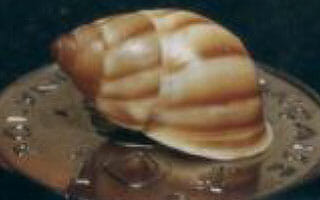Invertebrate Conservation
Partula Snail
 Partula snails are a group of small tree snails, approximately one-half to three-quarters of an inch in length. Their shells feature grey or brown spirals sometimes marked with white. Found on the Polynesian islands in the South Pacific including Tahiti, these shells were once used to make jewelry and to decorate Polynesian ceremonial garments. Partula snails are of great interest to science because they have adapted into a remarkable variety of species utilizing different habitats on different Polynesian islands.
Partula snails are a group of small tree snails, approximately one-half to three-quarters of an inch in length. Their shells feature grey or brown spirals sometimes marked with white. Found on the Polynesian islands in the South Pacific including Tahiti, these shells were once used to make jewelry and to decorate Polynesian ceremonial garments. Partula snails are of great interest to science because they have adapted into a remarkable variety of species utilizing different habitats on different Polynesian islands.
On Tahiti, Partula snails have been nearly wiped out because of a botched attempt at what is known as “biological control”. Giant African land snails, a large African species of snail, were introduced to Tahiti to be a source of food for local people. The African snails did so well in Tahiti that they became a serious threat to farmers’ crops, and a predatory snail, the Florida rosy wolf snail, was brought to Tahiti to eat the African snails and control their numbers. The wolf snails also ate Partula snails and caused four of the eight Partula species to become extinct in the wild.
One of those species, Partula nodosa, was saved from complete extinction and sent to zoos. The Detroit Zoo was one of a small handful of zoos keeping these snails and at one point, all the Partula snails in the world lived at the Detroit Zoo. The Detroit Zoological Society (DZS) now participates in a global program, the Partula Programme Consortium, which manages a captive breeding program at zoos in the United Kingdom, France and the United States. One hundred snails were released back to Tahiti in the summer of 2015, and another 60 snails were released in 2016. In 2018, an additional 80 snails were sent to Artis Zoo in the Netherlands for eventual release to Tahiti. The DZS maintains a colony of Partula nodosa for future releases.





